Friday, May 26, 2006
Lesson-27 : The Flattened Major Scales : Part-2

So theoretically, the next major scale F(b)- Major will have B-Double flats and so on…..
Omitting other double flat majors…
From C-Major to C-Flat Major, Let us carefully watch the Sequence of notes flattened each time… and list it….! (refer to the last column of above table)
They are….. B, E, A, D, G, C, F…..!
Oh God…. What a striking mathe-magic we are getting here…..!
When compared to Sharps sequence…this Flat sequence is…Exactly the Reverse of Sharp sequence….!
Is it not amazing……!
Incidentally the sentence given for Sharps can also be reversed and still makes sense…!
Battle Ends And Down Goes Charles Father !
Remember this sentence for Flat Majors….!
So…You are having knowledge of 15 Majors now in terms of Sharp & Flats....
And you agree that theory of music is easy to figure out with little bit of maths and logic…!
But, the practical portion is not…!
You have to do a lot of hard work to remember and play them in an instrument…!
A lot …lot ….lot….. practice….!
For theorists… just a careful remembrance of these observations and logics will do…!
If we cannot play we can make the others play and listen and observe…!
Now-a-days…”others’” list ….has added the Computer also…!
So we can still travel a lot into the WCM theory zone…!
But take a while, to consolidate all the Major scales, in terms of Sharps, Flats…..Their relative naming each time….!
The various intervals formation.. etc…etc….!
The visualization of these major scale on a instrument arrangement…their sound quality and feeling….!
FEEEEEEEEEEEEEEEEEEEEEEL That….!
Lesson-26 : The Flattened Major Scales : Part-1
Let us continue our analysis of ....what else…same Major Scales…!
Just earlier we saw the Major scales with sharps ..in increasing order...!
This time we will study about the Major scales with Flats !
Though all of you are familiar, let me repeat the pattern of Major Scale which is
(Whole + Whole + Semi ) + Whole + (Whole + Whole + Semi)
The pure white keys make the C-Major : C – D – E – F – G – A – B – C
Jusr refer the following figure of keyboard also for easy reference!

While enlisting Sharps usage in Major…..we went for Perfect 5th upward every time from the previous one…..!
This time can you guess…what…we are going to do....?
Just travel Perfect 5th downward each time….! That’s all….!
Starting from C….! travel perfect 5th in reverse direction.....You will land up in F…. !
[Alternatively… A perfect 5th downward means… Perfect 4th upwards…which is easy for you…! ..
but sharp means going upward… and flat means going downward….
So this convention…
Also we are traveling symmetrically on either side left (upward) and right (downward) of C…Major........by a Perfect 5th distance…..! ]
So our first flat major is F-Major…..
Follow the standard pattern of major scale… and you will get these
F – G – A – ………
Now if you select B for the next letter, you will land up in whole tone against the requirement of Semitone… So what…?
Come to the black note before B and express it as B-Flat…..
and then proceed with C – D – E – F …..
Yes….the last Semi between E & F automatically got matched…!
So the major scale on F is constructed as follows :
F – G – A – B-Flat – C – D – E – F
So the new black key is the 4th note ie the Sub-Dominant ….
Hope you don’t get baffled by the jargons, finding etc….now….! Are you ??
So for the next 2-flats major, we should travel a Perfect 5th downward from the present F-Major … (or travel Perfect 4th upwards…)….
Which is nothing but the B-Flat ….the note just now blackened…sorry… flattened….!
So this is another finding…that….
Every time the next Major scale in the flat-major scales series is nothing but the latest additional note Flattened in the previous scale…..! (and located as 4th note of previous Major….) …
( Let me use the small letter (b) for the flat to take care of HTML constraints of the posting )
So B(b) – Major is as follows :
B(b) – C – D – E(b) – F – G – A – B(b)
So next major scale is naturally the 4th note E(b) – Major which is as follows :
E(b) – F – G – A(b) – B(b) – C – D – E(b)
If we proceed on these series in this manner… …..
we will first exhaust all 5 black keys …….and then …..
add the two white keys as B & E representing them as C-Flat and F-Flat……
then onwards….add double flats to represent remaining white keys….!
Everything is same as the case of Sharp Majors…..!
So easy to learn mathematically ! Of course a lot of efforts and practice required for practical usage !
Wednesday, May 24, 2006
Lesson-25 : The Major Scales with Sharps - Analysis : Part-3
Maths helps us a lot in analysing and understanding the Music..!
Do you realise that….?
As explained earlier, the addition of black notes ( Sharps) occur in a pattern..! It's a beautiul pattern !
Our series of Major Scale starting from C .. every time jump to the perfect 5th (meaning the 5th or Dominant of the previous Major scale) and make that note as the Tonic or first note of the new Major scale.
Let me summarise the series of Major Scales…
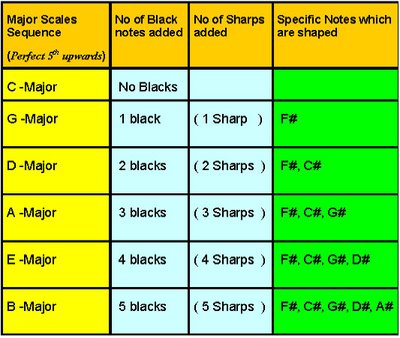
Now, continuing the abvoe series, the perfect 5th of B-Major is F# and hence next scale has to be F# Major and the note that need to be sharpened is E … ie… E#....
Note carefully, E# is not a black note
for all practical purpose that is a white note F….!
But the naming convention makes us to say that as E#...thats all !
Same way, next Major Scale after F#-Major is C# Major and this one will sharp the fifth note B ie B#..which is again not a black note and only the white note…C…
So we have completed one cycle of 7 notes sharpened.
Let me add the above two Major scales in the list…!

Theoretically, let us try one more Major in that sequence… which has to be G# Major…
Now we will land up in F-Double Sharp (F##)..!
If you sharp F two times, you land up in G (which is semi tone below the G# and thus ok.)…!
So the notes are same,,, but expressing is different…
May be slightly (???) confusing in the beginning…but mathematically easy to recognize…!
So you can add the remaining double sharp major scales also… but for the time being we will leave it, as these have not much significance…!
What is important is that we have understood that :
Major Scales starting on different keys can be easily formed based on the simple observations of sequence of notes getting sharpened when proceeded in Perfect 5th….!
That’s all. !
It is important to remember the sequence of Major scales that are coming one after another ….
And at the same time… more important is to remember the notes sharpened in each Major scales..each time..!
The notes getting sharpened in sequence are :
F, C, G, D, A, E, B
(after that …? Easy…..double sharp the letters in the same sequence…)
To remember this, the following sentence may be noted:
Father - Charles - Goes - Down - And - Ends – Battle
Remember this,, you will easily get sequence of sharp notes…of course the corresponding major scale is one letter next to the last sharp…!
Enough for today to assimilate…!
If you want a little bit go further…. You can attempt the following exercises :
1. Using Crotchets, try to write each of the Major scales in a stave ..one octave ascending and then descending… Write the sharp in front of the notes as applicable.
2. Try to play these Major scales one by one on the key board slowly….
3. Try to write yourself any two notes one above another…and check yourself the interval….and name the note as Dominant, Tonic, Mediant etc etc…
4. Whether these two notes are coming in any Major scale ? some time forming part of more than one major scales also ?
5. If more than one major scale, note and name the notes according to that Scale…!
More you go deep, more you understand…the inter relationships….!
Don’t get tensed about the complexity….If you have understood the basics concepts…. You are 90% through…!
All the other things will come …by practice…just sheer practice…..!
As IR says in one of his interview…. "Music Music nu… paithiyamagave aaganum… (You should become mad after music….to achieve this..) “
IF we have luck and divine intervention…. And of course…if we have the TIME…. We can attempt that…!
Sunday, May 21, 2006
Lesson-24 : The Major Apartments - Sharp Analysis : Part-2
Black notes are placed in a particular fashion in between White notes…in the piano/keyboard !
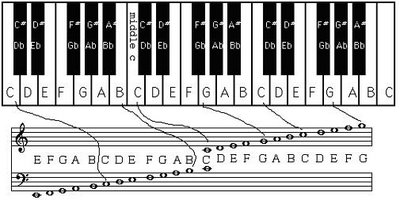
They are denoted as,
either Sharp (#) of previous white note
or Flat (b) of succeeding white note…
For example, You can call the black note next to C as either C-Sharp or D-Flat…. and so on...!
Then the question arise…in G-Major scale, whether the black note shall be called F-Sharp or G-flat…
The answer lies in the simple rule that is :
to form a Scale using the seven notes (alphabets)..
“Use each letter certainly once…but ONLY once…”
That simply answers why it is called F-Sharp in G-Major..
If we use G-Flat, we use the letter G twice…….which is not correct……. and also we are not using the letter F at all.. again not correct……
Also observe that the interval title will change if we use the different letter names…!
For example : E to F-sharp…. we will call it…Major 2nd…….
But in case of using flat, E to G-flat will have to be called a kind of 3rd……. Diminished 3rd….precisely…..!
Even though we are talking about the same two keys in a piano/ keyboard, even though the sound quality of the interval is same…the name changes…!
Symbols like Sharp and Flat (and one more symbol called Natural….meaning returning to normal by canceling the sharp or flat effect…. We will see later…..) are called Accidentals
So using the right kind of accidentals is a must while notifying the black notes…!
Returning to our G-Major scale analysis……
Nothing new to add about this G_Major…since we know a lot about the C-Major… the basics are same…
Now G has become Tonic, A is Supertonic, B is the Mediant and so on….!
All the interval pattern remains the same… only the letters change…!
Whether it is Tonic to others…or… any note to any note…we can manage naming intervals…! Can we ….?
SO whether it is C to G in case of C-major or G to D in case of G-Major, the interval is same…Perfect 5th….! And so on…!
But one thing I want you to observe…..!
I deliberately made you to climb 8th floor…ie … from C to G......in terms of musical interval, We reached a Perfect 5th above the Tonic of C major…. To reach the G-Major…
and we found the note F is sharped..to preserve the Major scale…and one black note is added…! ……
Which is….one letter before the tonic we selected to analyse…! F-Sharp…!
If we generalise this as a finding…. And try to analyse the next Major by selecting the note a Perfect 5th above the current G-Major…..which is nothing but D…..!
Can we say blindly…the D-Major will have 2 black notes…?
In addition to already selected black note of F-sharp….This time the note before D….. which is “C” will also be sharped to preserve the Major Scale pattern…?
Try it… you can’t believe it….our hypothesis is right….absolutely right…..!
Looks like some algebra….series….!
So D-Major is D-E-F#-G-A-B-C#-D
If you grasp this simple principle…. You can follow any Major scale…. starting from C onwards…..!
Major scales in steps of Perfect 5th starting from C-Major are :
C-Major, G-Major, D-Major, A-Major and E-Major.
Till such time you exhaust all the 5 black notes and you will ask me what to do next…..?
Simple….! Add one more sharp…. And make it Double sharp….. meaning you climbed two consecutive notes above….!
So after E-Major, the Perfect 5th above scales are:
B-Major, F#-Major, C#-Major...... etc etc.
That ends one cycle from C to C# Major.
So try yourself the major scales on all 12 notes starting from C onwards….using the sharp technique…..!
Each time note down the notes sharped so far….! And try to tabulate the exercise as a summary.
That’s very big climb for us in terms of our lessons….!
Completely knowing all Major scales of sharp…!
You are not only wiser now, you are Sharper also……!
Lesson-23 : The Major Apartments - Sharp Analysis : Part-1
Let us go back to our Apartments Analogy.
We are in our WCM Colony.
And we did locate the Major apartments which indeed a 12 storey building…!
And to start with we visited the Ground Floor House ie C-Major…
We had the glimpse of all Seven members and tried to understand the various relationships between them.
Now it's ime to move up to the upper floors of this House …. Let’s go..!
But climb with me straight away to 8th floor….Forget for the time being those intermediate flats C#, D, …E, F, etc. …..and you see we have reached… G-Major…!
Enter it, you feel this is the same type of look…like C….! Again the seven members of the flat welcome us…!
Of course… now the leader of the house is “G”…!
Person is same… but the role title is different….G is the leader and D is second leader.. and so on… !
but…check carefully…
you find one person is "missing" and another new person has taken his place…!
Like in the long serial TV drama…the character remain same… but that is played by a new actor or actress….!
Who is that ?.. that is indeed F-Sharp… and F has left the scene…!
Why and how did it happen….?
To explain that, putting aside the above example for the time being….let us get into the business of mathematical analysis as usual…!
Our earlier understanding of Major scale stipulates that we need a pattern of adjacent notes obeying
(Whole+Whole+Semi) + Whole + (Whole + Whole + Semi)
When we start the Scale with note G, all the other notes A, B, C, D, E takes care of these interval…….
But the moment we select F, this is not obeying the Whole tone gap required ( since gap between E to F is only a Semi tone )…
So you have to jump to one more next key to reach F-Sharp (F#) thereby satisfying the criteria…
and it indeed fulfils the next & last semi tone requirement as F-Sharp to G is exactly that…!
So the G-Major notes are
G-A-B-C-D-E-F#-G … That’s it !
So, in comparison to C-Major (all-white-key-scale), in the case of G-Major, we have added one Black-member to the family by replacing a White member…!
Hope this is clear !
Some more clarifications on representing and denoting a black note will be given in next posting....
Friday, May 12, 2006
Lesson-22 : Intervals Between Any Two Notes
( For those who pick-up fast and want to proceed further, Just for the continuity of the previous topic, the following discussion is given.. Pure mathematical analysis. But for those who find it difficult to follow, just read the following and forget it….! We can pick these up later ! )
In previous discussions, we named the intervals of each of the seven notes with the Tonic.
It is basically hinting about the number of notes above the reference note as well as adding the prefix of Major, Minor etc…
In the case of Major Scale, All the intervals w.r.t. Tonic are Major except the 4th and 5th which are called the Perfect.
Also we had the hint about the naming of other intervals, like Minor, Diminished and Augmented intervals in relation to the Major & Perfect intervals.
Using the same technique, we can find the intervals between any notes of Major scale (other than w.r.t. Tonic as reference note…) or for that matter any note to any note whether it is a major scale or otherwise.
I will provide you a reference list which will help in naming the prefix of intervals !
Earlier in our numbering convention, we used 1 to 13 for each of the white and black keys..
Let me re-state that table here :

If you want the interval between particular notes,
Deduct the serial numbers of concerned notes as per above and you get how many Semitones they are separated….!
Then from following table you can get the prefix to be added
and the numbering the interval is easy one which is just counting how many notes above the reference point..!

( This is one general table just to guide. Bracketed names are just theoretical possibilities and may not be relevant in many cases also as per WCM norms.
But in case of Carnatic reference they may crop up that’s my guess !
Please remember the numbering shall be based on the distance of the notes alphabetically…!
But best method to find the interval is
- to assume the first note in question as the Tonic of the corresponding Major Scale
- and automatically recall the Major scale intervals
- and from there the 2nd note in question is compared whether it is equal or above or below the referenced Major Scale interval etc
- and then name of that prefix is found out…
From the above, if you deeply analyse all sort of possible intervals between any two notes of Major Scale, (remember now we are talking about intervals other than w.r.t tonic also ….! ie intervals between any two notes...) , it is quite possible it may have some minor intervals also….
(example : it is Minor 2nd , between E&F or B&C of the C-Major Scale. etc. etc..) ..
So a Major Scale has some Minor intervals also….!
Similarly, later on we will learn a Minor scale which will have some Major intervals also…!
So don’t get confused & be careful between the various terms like a Major or Minor intervals and the Major or Minor Scale etc…
( Same is the case with the Major and Minor Chords classifications, which we will discuss later….) ….
All are different….!
How confused are you today… ???
Best wishes for your stability …. !
Those who have not read and are fortunately still stable, w.r.t our WCM-Colony Analogy, let us see further Houses in the floors above of our C-Major Scale ….!
In our next discussion…!
Thursday, May 11, 2006
Lesson-21 : Intervals & Relationships - Part-2
(continued from Lesson-20.......)
We are trying to establish the relationship between the Tonic, the first note of a scale and the Other notes of the same scale.
The relationship is expressed in terms of the interval between two notes.
As we are clear that, the Major Scale is consisting of seven notes.
The relation ship is expressed through the interval, which is primarily named by the number of notes above/ below the first reference note.
Taking Tonic as the reference,
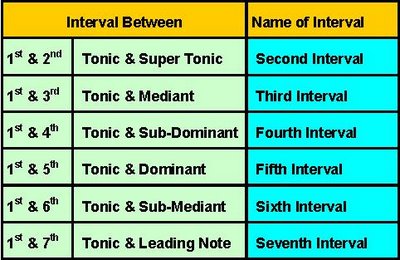
Its easy to learn interval…. Isn’t it ?
Just , 2nd, 3rd, 4th, 5th, 6th, & 7th ….. that’s all. Ok.. ….
As we generally know, the interval between 1st & 8th is called an Octave.
In case of anything above them viz. 9th, 10th etc are repetition of the same intervals like 2nd, 3rd and so on.
These are called Compound 2nd, Compound 3rd and so on.
Still, some small problem…..
This only give a general title of the relationship , but if you want to go further deep to feel the characteristic of the relationship, we need to add certain additional title to that.
For example, a 3rd only denotes the interval of a 3rd note from the reference note.
As we already know, for the third note, depending on the type of scale, we may be using a white key, or a black key above or below etc…
So, we have to specifically say which type of 3rd is this .
This is done by adding certain Prefix to the simple title of 2nd, 3rd etc
The various such prefixes which are normally getting added to an interval number are as follows :
- Minor,
- Major,
- Perfect,
- Augmented &
- Diminished
Basically, such classifications were formed on the traditional study of the Sound quality of these intervals and conclusions arrived at.
For the time being we will not get into those complications of reasons for the name and others.
What we will learn just now is the titles associated with our normal Major Scale which we are now concentrating upon.
In the case of a Major Scale, the name of these intervals (w.r.t. Tonic … don’t forget that….! ) are as follows ;
The 4th & 5th are called Perfect intervals.
The 2nd, 3rd, 6th, 7th, are called the Major Intervals
With this we can summarise the names of the intervals in a Major Scale as follows: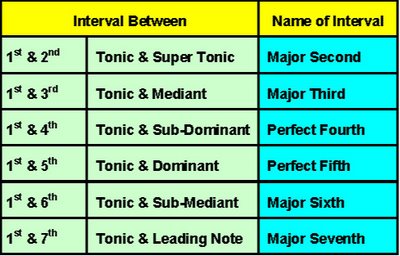
You just believe it ! And Memorise it !
Easy, because in Major scale everything is Major intervals except the 4th and 5th which are Perfect intervals !
Any Major Scale which follows the rule of (Whole + Whole + Semi) + Whole + (Whole + Whole + Semi ) will have these intervals w.r.t. the Tonic.
Just for your idea :
• Any interval a semitone lesser than Major interval is called a Minor Interval.
• Any interval a semitone lesser than Minor interval is called a Diminished Interval
• Any interval a semitone more than a Major interval is called a Augmented Interval
We will discuss them later.
Now we know some more jargons…and we are a little bit more wiser….!
Hereafter, if somebody talks about major, minor, augmented, diminished, perfect…etc etc… we need not turn our faces & ears away with some aversion, ……
Rather now, we will listen to them a little more confidently, attentively… !
Later on, while we learn our chords and related subject, these terms will be repeated a lot of time…
and by that time, we will be master of these terms…!
Lesson-20 : Intervals & Relationships - Part-1
Let me give you some analogy.
Assume the whole range of WCM as a housing Colony. There may be many tall Multi-storey-Apartments in that colony.
Now, we can concentrate one such apartment called the "Major Apartment". In which, we have identified a small flat/house called "C-Major Scale" !
Naturally, house will contain some People inside; in our case the Seven Notes of the Major scale!
So far, we have analysed and understood the overall pattern/ look of this house !
We have also got introduced ourselves and had a hand-shake with the seven members of this house and got their names also ! (Tonic, Dominant etc..)
We also guessed from the stature & appearance at a first glance, who is the House leader (is it not the Tonic ?) as well as some important other fellows among these members….!
So far so good… !
But don’t you feel, if we could remain some more time inside the house amongst them and do some careful observations, we can better understand the inter-relationship & behavioral pattern amongst them a little more ??
Incidentally, you can also make a better binding with each one of them in that process ?
Yes… we can do that…! And we are precisely going to do that just now…!
Anyway, the question that baffles you is :
Why at all this inter-relationship shall be understood ?
Good Question!
You may agree with me that, this abstractive term relationship is what binds the people together;
Just like in between Husband and Wife, with Parents and their children, brothers and sisters, elder generation and younger one etc etc...!
Each relationship has its own characteristics, pluses and minuses etc.
This relationship and the equations are what that create, balance and maintain the HARMONY in a family life.
Do you agree ?
So, Music also needs the Harmony;
particularly the WCM foundation is laid on this Harmony.
So to create, balance, understand and maintain the Harmony, we must understand the relationships between the basic constituents, i.e., the musical Notes!
While defining the pattern of a Major Scale, we indeed studied one such relationship, ie the gap between each adjacent notes, say 1&2, 2&3, 3&4 etc etc.
Now, we will look into another kind of relationship; i.e. the relationship between a particular note, say Tonic, and all other notes to this basic note, Tonic ! i.e relationship between 1&2, 1&3, 1&4 etc etc...!
In our human relation ship we have names for denoting various relationships, like Father, Mother, Sister etc etc;
Like that we need some naming convention to use them.
Let us see that !
Wednesday, May 10, 2006
Lesson-19: Anatomy of Scale : Part-2 - Feel the Scale !
Today just a few more points about the abstract part of a "Scale".
Mainly about the feeling of the various notes of the Scale.
Most of the following discussions are valid for both WCM and Carnatic scheme.
As earlier explained, each of the seven notes from Tonic to Leading note has its own distinct identity and creates some feeling in us .
This can certainly be felt while playing the scale slowly.
TONIC
Tonic, the starting note certainly gives that “I am the Basic and All “ feeling… !
i.e to say…when ever you are dwelling on this note, you feel some fulfillment.. and finishing effect…!
Most of the time, Song start with this note! Similarly most of the songs invariably end on this !
Even when you are passing on nearby notes like Leading note or Supertonic , you feel like either climb up or go down accordingly, to reach the Tonic and arrive at some balance !
Dominant
The next important note is the Dominant, which is like a fulcrum, center point, or mid point of a Scale range.
Certainly this one is the next, semi-balanced position where you can feel like staying there but at the same time not getting a finishing feeling for which you want to get back to the Tonic.
Its like while climbing stairs, you get a landing in the middle of the height and take some breathing, rest..... that kind of feeling..!
Its also true that in some songs, it will dodge you by giving a feeling as if it is the tonic !
(this kind of shifted Tonic feeling to dominant or other keys creates a lot of identification crisis in raagam for Carnatic people ! )
If you sing/ play the Tonic, Dominant and the next tonic octave higher, in succession , up and down repeatedly, you can feel the entire range of the Scale you are covering.
Play and feel it !
Usually, singers before starting the song, trying to ascertain whether they are capable and comfortable to sing the range of raagam/ scale, they practice Sa-Pa-Sa.
Like sea-saw board the bottom-middle-up and back the Scale range sounds for you.
Those who have heard the IR’s devotional album, Geethaanjali, might have noted this!
He starts with Sa –Pa–Sa filled with reverberating, Ohm type of sound, emanating from the instruments , and repeating for a few times and then getting into Saaaaa – Sagalamum Neeee, Paaa- Saaaaa- Sarvamum Nee, Sangeetham Nee… etc.
What a Classic feeling setting a reverberations in you…!
Another small piece of information: IR always finish his orchestra while recording or otherwise, with all his players playing the Sa – Pa – Sa in a particular fashion…!
Its like singing Mangalam song in (Sourashtram or Madhyamavathi raagam) in any Carnatic Kutcheri to finish the function.
Thus, Tonic & Dominant are the very essential notes of the Scale.
As we earlier saw, the Major scale hinges on Dominant with two identical parts on either side of it !
If you consider those four notes identical sequence C-D-E-F as well as G-A-B-C, it is clear that if C is the Tonic (starting note) for the first half, G is equivalent to be the Tonic of the next half !
Coming to other notes :
Between Tonic and Dominant, Mediant ie the third note, is in mid way between them and so the name.
Mediant
As we will learn later, a slight change in the Mediant will shift the scale from a Major scale to a Minor scale. Same is the effect of Sub-Mediant which is the 6th note and also can cause such effect.
Leading note
The Leading note is so called, because it always lead to the next Octave Tonic.
I bet that, if you play the scale after coming to this 7th note and extend the note playing for a little longer and wait ….........
you will tend to reach the 8th note ie Tonic, octave higher…! To get a satisfactory ending…!
Other notes
By the way, most of us know and add the word Sub or Super to denote the lower/ bottom or upper/ higher position. Like for examples, Sub-script, Super-Script, Sub-critical, Super-Critical etc. etc.
Same way, The note above Tonic is called the Super-Tonic and the note below the Dominant is called the Sub-Dominant.
The 6th note is called Sub-mediant and you can justify that if you see it from the Tonic as center.
Mediant is 3rd higher above tonic and Sub-mediant is third lower from Tonic.
(These I am putting just to remember the name from various angles! Don’t extend the arguments why not Super Dominant or Sub-Tonic etc….Spare me……!)
Ok …The essence of our discussions is,
We do ascertain to ourselves as of now, if we say Tonic, Supertonic, Mediant, Sub-dominant, Dominant, Sub-Mediant and Leading note, we mean the first, second, ….. to seventh note of a Scale…
ANY scale for that matter….!
We are very clear about that !
Monday, May 08, 2006
Lesson-18 : Anatomy of Major Scale : Part-1
What we did in our last discussion is
-to establish an identity of a typical 7-notes group called Major scale,
- by defining the pattern of the gap between each successive notes of this Major scale.
Let us also recall that in the Lesson-16, we assign key number 1 to 13 for the Octave, including the black keys, and then find the key numbers of all the white keys which are required for the Major Scale.
So, now comes a small confusion, i.e. how to denote a key ?
One way is , whenever we want to refer, use the key number of the white+black piano keys sequencing, which is 1 to 12
Another way is, use the numbering order of the 7 keys of the Scale itself (ideally we would prefer to notify them First note of Major Scale, Second note of Major scale etc in that sequence).
In order to help the Second way, again we can use two methods, viz.
1) use the Roman numerals I to VII to denote the Seven notes of the Scale, as follows :
(Using the same table of yesterday, our Major scale on C can be represented as follows):
So we have two distinct numbering systems 1 to 12 for the Keys and I to VII for the Scale.
These Roman numerals are valid for any type of scale (including the new scales which we will learn).
I hope this is simple and clear to you!
2) The another method to denote the 7-notes of the scale is using the traditional "Naming convention" (instead of Roman Numeral or as an additional representation system along with Roman Numeral) is calling them by a special unique name for each of the key of the Scale.
(This naming system is valid for all type of scales whether Major Scale or Minor Scale which we will discuss soon ) .
These names are given below :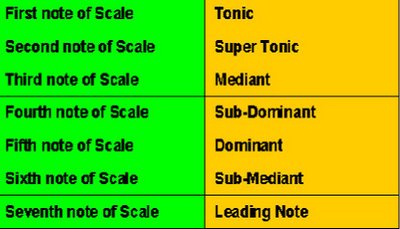
(for those who knows Carnatic system, they can correlate them to the special words used in Carnatic to denote 7 swarams (notes) as Shadjam, Rishabam, Gandharam , Madhyamam, Panjamam, Dhaivadham and Nishadham and shortly denoted by Sa Ri Ga Ma Pa Dha Ni )
For Clarity, I will make some more elaborations. Listen carefully :
In case of the Major Scale, starting from C, the key numbers sequences of the Seven notes are 1-3-5-6-8-10-12-(13)
And we will call each of them from first note as Tonic, second as Supertonic, third as Mediant etc etc.
Suppose imagine some other scale, which uses the keys 1-2-4-7-8-10-11-(13), which may be the combination black and white keys.
We will still call the first note as Tonic, 2nd note as Super tonic etc…..
So naming convention like Tonic, Super Tonic etc give you only the Relative reference name
whereas the exact key numbers like 1, 5, 7, 11 etc or the key names like C-D-sharp, E, F-sharp, G etc give the Absolute reference name.
To say further, take the case of the sound, note "F".
Though. this key will poduce the same sound, whatever way you call it, but in a particular scale it can be Tonic, in another scale it can be Dominant.
So, naturally, just by giving such Ralative Reference name like dominant, tonic etc, you cannot define or find the scale.
(So the same case is in Carnatic system also! … Just by saying Sa Ri Ga etc, you cannot define the Scale (Raagam) !
So you might have seen, they are using some way-out by indicating R1 D2 M2 N3 etc……as you have seen in the various technical discussions!….)
Needs a little bit concentration, that’s all, but all these are very simple concept !
Analyse it and convince yourself.. !
When we further go into deep, you will automatically understand this !
(usually when we are in High school, our ABCD is very clear (not the grammar ! ),
in College, multiplication/division is clear ….(not the Calculus ! .) .
Like that ….Don’t worry, one day we will get it…!)
Hope this is not too much for today !
Friday, May 05, 2006
Lesson-17 : Scaling the Scales : Part-2
Hi All,
We just saw the pattern of a Major Scale which is as follows :

Conversely, we can also say that “ if any scale has the above gap pattern, then it shall be a Major Scale. “
Very simple….!
Certain other observation from the above interval (gap) pattern :
The total of these intervals are 5 Whole + 2 half = 6 Whole tones ( 12 keys x each half tone = 6 Full tone )
So, one octave is consisting of 6 whole tones and each consecutive notes of keyboard keys will be semitone distance apart.
(So you can conclude the White and black key relation is usually a semi tone apart…! Anyway we are not concerned with black keys directly now…!)
Another observation is that there is a symmetric pattern around the center point
i.e. C to F and G to C has similar pattern viz. ( Whole + Whole + Semi ) !!!
These two identical groups are added by the joining Whole tone in between F and G…!
In earlier period only four-notes scale similar to C to F existed and the present evolution of Major scale was the joining of two similar identical four-notes scale !
Which are easy to sing as well as easy to find in a key board system, all white keys!
(For Carnatic buffs : Such similarity you can get in raagam Mayamalava Gowla. So any Carnatic learning starts with this raagam for simplicity in singing due to this similarity )
So some kind of introduction we are having now with the Major Scale !
Lesson-16 : Scaling the Scales : Part-1
Let us the assign each key a number from 1 to 12 for all the white and black keys in the order they are placed in a piano / keyboard, starting from Middle C for one octave ie upto next C, OK ?
Let us use the # symbol for the black keys, in between (usually they are called sharp of previous letter)
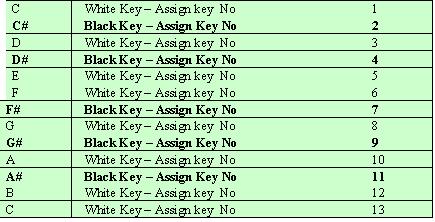
Considering our Major Scale, which we got introduced to in last discussion, which is pure white keys between C to C,
the key numbers for a Major Scale will be like this :
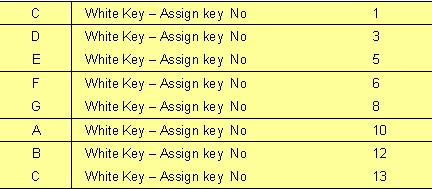
I think it is so simple for every one of you ! We have just omitted the black keys from the previous list and got the above list.
Now, one small relation ship we want to establish and analyse between two consecutive keys in the above Major Scale. For which, the following definition is presumed :
If the difference between the assigned numbers of the two adjacent key / notes of the major scale is ONE then the gap is called a Semitone.
If the difference is TWO then the gap is called Whole Tone.
With the above, analyse the gap between two adjacent notes of above Major Scale like this:

So let us define that,
A Major Scale shall have a gap pattern of adjacent notes as follows :
( Whole + Whole + Semi ) + Whole + ( Whole + Whole + Semi )
Tuesday, May 02, 2006
Lesson-15 : Back to The SOUND Track : SCALES in WCM !
[Our further discussions (which we will be continuing for next few sessions), does not require the details discussed earlier about Time element.
So, those who wants to consolidate their understanding on those topic related to Time, they can still do that and can also proceed now with these discussions, without getting into any problems.
But current lessons DO require the reasonable remembering of the keys and letters we attached to those sounds and their visual relative placements in a key board.
Both Treble Clef and Bass Clef octaves will be referred. You can absolutely use the piano/ keyboard all the time (either real one or the software one) for comparison while reading, even if you don’t remember these names etc.
As already promised, I will simplify the matter by omitting the black keys, but still you should remember the white keys placement in relation to these black keys then and there ! ]
Now back on Sound Track……
Let us concentrate on the seven notes C, D, E, F, G, A, B and C to complete one octave.
Imagine yourself amongst a collection of people.
- If that group is your office, then your style, function, behaviour etc follows certain pattern.
- If that group is your family, then you are a different person,
- and if it is friends' group then again you are showing a different personality.
Take the example of foreign languages like English, French, German etc.
Even though the alphabets use more or less remain same (in writing), based on the language chosen, the words, meaning it conveys etc become different .
Similarly,… even though the basic building blocks of life are Cells, they form different living being…
Such a "group behaviour" is exhibited by the musical notes also !
When you bunch these notes to a group in a particular fashion, they become a distinct group and the letter of that group also looks and behaves different in relation to that group pattern.
Such a group made of these musical notes (A to G) in a specific order is called the "SCALE".
So theoretically we can form numerous such groups and hence numerous scales.
But in WCM one such pre-dominant grouping is a scale called Major Scale.
This one is formed by grouping the letters starting from C to C omitting black keys.
In a piano keys these are all the adjacent white notes (please note I use the word adjacent and not consecutive still the black keys are coming in between, as you know) !
If you have a key board, what you can do is to slowly play these keys one-by-one from C (say middle-C) to next C in ascending order and in the same way play them in descending order also from top C to bottom C.
Whenever you reach C either at top or bottom of the octave, play it for a slightly longer duration.
Please play them slowly, repeatedly and repeatedly for umpteen number of times and fill your heart and mind with those pattern of sounds.
If you want you can play even three octaves of C to C (one octave below middle C and two octave higher from middle-C) in ascending and descending order….!
There is every chance that you will be reminded of many of the IR songs by now.
Can you list them ?
Let me help you with some of them…! (Try to Listen them also ….if possible)
1. Kodai Kaala Katre……Kulir Thendral Padum Pattee
2. Erik Karai Poongaatre…..
3. Poove Ilaiya Poove…….
4. Eriyile Elandha Maram Thangachi vacha maram…..
5. Aadungal Padungal.. Pillai Pon vandugal…….
6. Uravugal Thodarkadhai….
7. Nilaave Vaaa ..... Selladhe Vaa…
8. Paadha Kolusu Paattu Padi Varum…
9. Koondukkulle Enna Vachu…
10. Alli Thandha Boomi……..
The list is never ending one…! In fact you can cover 30 to 40% of IR songs (considering all kind of variations of this scale…) !
Mostly you will get a peaceful, jolly mood when you hear most of these songs !
So you can have some feel now about this Major scale !
Anyway, aim is to get a hang of it…so that … let us proceed with some more easy (?!) theories..!
About anatomy of these scale and the relation between their keys !
In mathematical way….!
Lesson-14 : Consolidation of Time Factor!
In fact, today’s posting is mainly to Summarise our understandings (numbered as US-1, 2 etc.) of Time related discussions so far :
US-1 : Sound Level and Time duration of notes are two important aspect of musical notes.
US-2 : Assuming an unit time duration, The following are the various time values of the notes frequently used in score sheets :
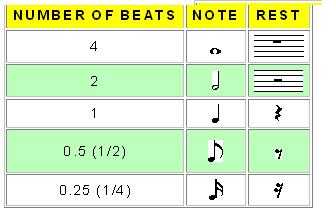
Whole Note (Semi-breve) – 4 units – White oval shape note without stem
Half-Note (Minim) - 2 units - White note with vertical stem
Quarter Note (Crotchet) - 1 unit - Black note with a vertical stem
One-Eighth Note (Quaver) – half unit – Crotchet with a tail added at the stem
(further halving of quaver, will halve the unit and represented by additional tails each time)
Similar to the sound, Silence also have time factor and are denoted by appropriate symbols.
US-3 : The actual duration of one unit of time duration is a variable one and determined based on the music, composer’s choice etc.
US -4 : Bar lines shown in a score sheet divide the musical notes into equal time period and this helps in easy grouping of notes and better reading of notes.
US-5 : Each bar will be consisting of notes of various time duration as per song requirement, but the sum-total of notes in each bar will remain the same.
This sum total in a bar may be equal to either 4 units, 3 units or 2 units. (These units may be normally crotchet and sometime other note values are also used . Also, there are some complicated time units also which for the time being we will ignore).
US-6 : Within bar also, notes less than one unit are grouped to make one single unit for better reading.
US-7 : The notes falling on the start of the bar are usually accented (stress is given).
Conversely , this give clue to identify the starting of musical bar and help in analyzing the notes and their time values.
Analyse IR songs as much possible w.r.t time value, bar divisions etc. Nobody is going to give you so much excellent, examples thorough practical lessons and illustrate so clearly like IR ! Utilise this opportunity to the maximum !
With these basic knowledge of Sound and Time, we are on the threshold of crossing the Nursery department of our learning!
My objective is to take you to the High School door steps and leave there for you to survive on your own further !
So Primary department is what we have to cross to reach high school door !
At this juncture, I would leave the “Time” matter as such, and will divert back to expanding our horizon of knowledge again related to the “Sound” Level of notes.
